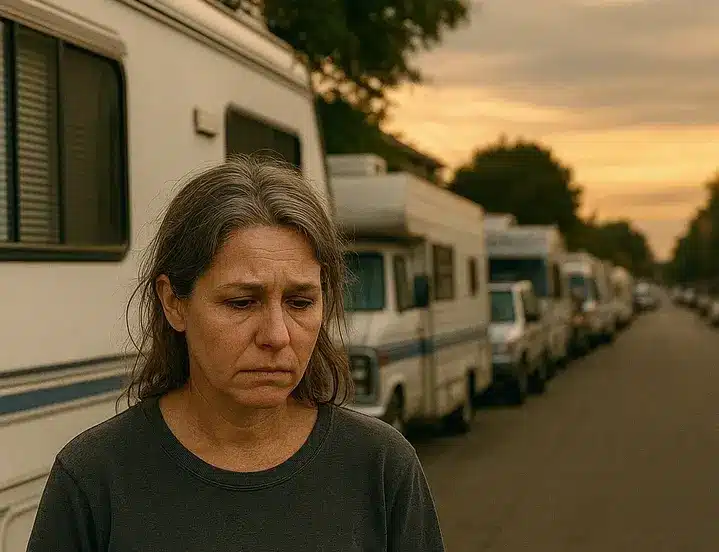A growing number of Americans are calling RV parks, vans, and even their cars home because housing has become astronomically unaffordable. This isn’t a distant future scenario—it’s happening right now across the country as rents skyrocket, property taxes increase, and government restrictions prevent affordable alternatives.
People are finding parking places for the night using apps and websites like iOverlander.com, filtering for dispersed camping and wild camping to locate free spots. They’re staying at truck stops like Town Pumps, Flying Js, and Pilots where they can park overnight safely with 24-hour security cameras. Others pay $400 to $500 monthly at RV parks while nearby one-bedroom apartments rent for $1,200 to $1,500.
One woman explained she had an 18,800-square-foot house with four bedrooms and four acres, but ultimately downsized to a 22-foot trailer. She shed belongings that once filled her large home, discovering she hardly misses most of it. Many find similar peace after adjusting to smaller spaces because the financial relief outweighs the sacrifice.
The RV Park Stigma and Reality
There’s long been a stigma around RV parks and trailer parks being places where trashy people live. However, that stereotype doesn’t match reality. Many RV park residents are ordinary Americans working hourly jobs or existing on fixed incomes where median area income simply doesn’t cover traditional housing costs anymore.
Renting a space at an RV park costs around $400 to $500 monthly, making it considerably more affordable than renting apartments in the same area. For people on fixed incomes or those earning hourly wages, this represents the difference between housing stability and homelessness. Some residents view their situation as choosing what’s important—deciding whether to spend life working to pay bills or finding alternative housing that provides financial breathing room.
Mobile home parks face similar judgment. One young person shared their experience living in a trailer and mobile home park as a single individual. Despite stigma, they own a three-bedroom, two-bathroom home where lot rent and mortgage combined cost less than a 700-square-foot apartment in their city. The person’s name is on the entire house, creating ownership that apartments deny.
Government Restrictions on Affordable Living
However, the solution isn’t as simple as buying land and placing an RV there. Even when individuals purchase property, counties enforce regulations preventing people from living in RVs on their own land. Code enforcement arrives with orders that residents can’t live in trailers on acreage they just bought because the government needs to tax those structures.
One individual explained their frustration: they want to build a barnominium—a barn covering an RV—on 10 acres they own. The county won’t permit this setup. Government officials arrive and demand residents disperse because continuous year-round living in RVs isn’t allowed. Properties must meet building codes that require permanent structures with wheels removed so tax assessments can occur.
The fundamental issue is that government won’t allow people to create cheap housing. They want tax revenue and building code compliance that ensures only approved structures exist. Politicians cite safety concerns when blocking alternative housing, but critics argue safety regulations sometimes serve as excuses to maintain control over housing stock and tax revenue.
County code enforcement frequently tells RV owners they can’t live continuously on purchased property. Regulations limit living in RVs to six months at a time or one month at a time, even when people legally own the land. The government wants wheels removed and structures permanently affixed to ground for tax purposes, regardless of owner preferences.
The Desperate Living in Cars
Some Americans have progressed beyond RVs to living in cars. Co-workers describe family members who’ve adopted car dwelling to save money. These individuals shower at gyms and sleep in vehicles because rent has become unaffordable. They’re making this choice not because they want to, but because traditional housing costs exceed their income.
One person described struggling to sleep in a car on humid Southern nights. Sweat rolls constantly, windows must stay closed to prevent mosquitoes and gnats, and the discomfort makes rest nearly impossible. Yet people continue choosing this because it beats paying $2,000 monthly for housing they can’t afford.
Many who’ve spent nights in cars recall army experiences where sleeping on the ground or in vehicles was expected. However, adapting to car living as you age becomes increasingly difficult. Hot weather makes it miserable. Yet people continue because they must. The alternative—paying rent that exceeds income—isn’t sustainable.
The comparison that resonates is the striking truth about America: “We always got money for war, but none for the poor.” This points to fundamental priorities where military spending remains unquestioned while housing for citizens deteriorates.
The Desperate Living in Cars
Across America, more people are turning to car living — not by choice, but by necessity. Rising rents and stagnant wages are forcing working individuals to find refuge in parking lots and gym showers. The contrast is stark: unlimited funds for war, but growing silence around housing insecurity. Change begins when we acknowledge that survival should not require sacrifice of dignity.
Explore Social Impact & Housing Policy Roles →The Scam of Homeownership
Some Americans argue owning a house has become a scam. Insurance costs have exploded beyond reason. One woman described her sister attempting to sell a Louisiana home because insurance became unaffordable even with weak policies that don’t provide real protection. Homeownership no longer represents financial stability when insurance companies can refuse claims and continuously raise rates.
The model of 30-year mortgages creates debt bondage rather than ownership. When people purchase homes, they’re technically paying for 30 years before achieving genuine ownership. By contrast, financing a van for six years means actual vehicle ownership in a fraction of time. Sure, risks exist, but traditional homeownership carries risks too—property tax increases, insurance hikes, maintenance demands that can bankrupt homeowners.
Insurance itself seems like a scam because companies frequently refuse payment when claims arise. Rates keep increasing, potentially doubling in a single year. Homeowners receive letters announcing property tax increases of $600 annually, homeowner’s insurance rising $60 monthly, propane doubling in cost. One individual received propane filling that cost $1,000 for a tank that previously cost half that amount.
The Property Tax Burden
Property tax increases represent another element breaking homeowners. People purchase homes cheaply, invest cash and physical labor improving properties, then face reassessment that triples taxes. Individuals who bought houses 15 years ago at affordable prices now cannot afford to remain in those homes due to tax increases.
Counties assess properties at dramatically higher values after improvement work, even when homeowners did labor themselves. A person buying a home at $130,000 who invested $120,000 cash in improvements received tax reassessment that tripled annual payments. They manually improved properties with landscaping, roofing, and complete interior renovation, only to face penalties through tax increases.
Property taxes fund libraries, schools, fire departments, sheriff’s departments, and infrastructure that homeowners may never use. Elderly people pay school taxes without school-age children. Municipalities demand new stadiums and infrastructure, then raise property taxes to fund projects that push residents out through affordability pressures.
Health Insurance and the Cascade Effect
The cascade of rising costs extends beyond housing. Health insurance through Affordable Care Act marketplaces can increase from $45 monthly to $660 monthly if tax credits disappear. Car purchases become impossible because vehicles cost more while interest rates skyrocketed. Finding reliable transportation matching previous $450 monthly payments grew unattainable.
Groceries became unaffordable. Subscription services continuously raise prices. Netflix, website subscriptions, and digital services all increase costs. One business owner described sitting stressed about money daily, knowing others face worse conditions. Many people, especially women, cannot afford leaving abusive homes because housing costs trap them in dangerous situations.
Community Response and Underground Networks
Despite challenges, communities are forming around vehicle living. Apps help people find safe parking spots. Social networks share information about which truck stops allow overnight parking and which areas avoid police harassment. People exchange tips about battery-operated fans for hot nights, shower facilities, and strategies for maintaining normalcy while living in vehicles.
Some individuals have embraced this lifestyle as positive choice. One person described a friend who became a travel nurse, purchased a small pull-behind RV, and traveled between assignments while saving substantial money. She kept her pet, maintained her profession, and achieved financial stability through mobile living.
Elderly friends sold houses at retirement, purchased RVs, and traveled America full-time without property maintenance obligations. They’re living their best lives through alternative housing. These individuals prove that choosing vehicle living can be conscious decision rather than last resort.
The Hard Truth About Fixes
The problem requires fundamental system reshaping that politicians won’t undertake. Real estate communities lobby against alternative housing solutions because they profit from traditional structures. In Japan, pod systems allow renting sleeping pods for $20 to $30 nightly—simple, functional spaces without excess. Historically, houses weren’t always this expensive nor consumed this much life focus.
Until systemic changes occur, Americans will continue facing choices between unbearable housing costs and alternative living arrangements. More people will become homeless as expenses climb continuously. The system currently funnels wealth away from ordinary Americans through property taxes, insurance, rent increases, and regulatory barriers preventing affordable alternatives.
Frequently Asked Questions
Q: Why are people choosing to live in vehicles?
A: Renting RV spaces costs $400-500 monthly compared to $1,200-1,500 apartments. Vehicle living provides housing when income can’t support traditional options, particularly for those on fixed incomes or hourly wages.
Q: Can you legally live in an RV on your own property?
A: No. Counties send code enforcement telling people they can’t live year-round in RVs even on purchased land. Government wants permanent structures with wheels removed so they can assess property taxes. Regulations limit RV living to 6 months maximum.
Q: Why won’t governments allow alternative housing?
A: Government requires building code compliance and wants tax revenue from permanent structures. Officials cite safety concerns, but critics argue these restrictions maintain control over housing stock and tax bases, blocking affordable solutions.
Q: Are property tax increases making homeownership unsustainable?
A: Yes. Homeowners who bought properties cheaply then invested cash and labor face reassessments tripling taxes. Those who purchased homes 15 years ago can no longer afford to remain due to tax increases, even when they did improvement work themselves.
Q: What about the stigma around RV parks and trailers?
A: RV parks get dismissed as trashy, but many residents are ordinary Americans working hourly jobs or on fixed incomes. Mobile home parks provide three-bedroom, two-bathroom homes cheaper than 700-square-foot apartments, yet face discrimination.
Q: Could the housing crisis be solved?
A: Solutions exist like Japan’s pod system for $20-30 nightly, but real estate lobbying blocks alternatives. Fundamental reshaping is necessary that politicians won’t undertake, so the crisis continues escalating.




